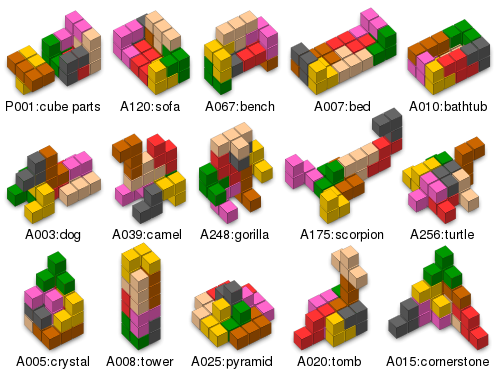I’m sure most reading this have played with a Rubik’s Cube. But how many here are familiar with Soma Cubes? Soma was the Rubik’s Cube of its era. (*)

The word soma originates from the Greek word for body. The Oxford English Dictionary defines it thus:
soma (noun: soma; plural noun: somas)
1. (Biology) the parts of an organism other than the reproductive cells.
2. the body as distinct from the soul, mind, or psyche.
In 1933, Danish polymath Piet Hein was watching a lecture on quantum mechanics conducted by Werner Heisenberg when he invented Soma: a 3x3x3 cube of 27 cubes in total, made up of seven pieces. One is a three cube piece in a V shape, the others are six of the seven possible combinations of four cubes. There are knockoff versions of Soma that include the square (yellow in the above image), leaving out one of the mirrored grey pieces.
The main goal of Soma is to form a cube from the seven pieces. John Conway and Michael Guy proved mathematically that there are only 240 possible cube solutions, excluding mirrored or rotated solutions. As seen in the picture below, there are other shapes which can be made using the Soma pieces. The Soma Cube I had when I was younger contained a book listing other things to make, such as two different castles. There are also shapes containing 27 cubes which have been proven impossible without substituting pieces from another cube (the Gordian Knot, and the Skyscraper).
Thorleif’s SOMA page has a huge trove of puzzles, links, PDFs, including Martin Gardner’s 1958 Scientific American Column, and many others. This youtube link demonstrates (spoilers!) how to form the cube and many of its other constructions seen below.
If you know someone obsessed with the Rubik’s Cube, introduce them to Soma.

(* And Rubik’s Cube was the Tetris of its era. What is it with us that we like block shaped toys and games? Interestingly, the Rubik’s Cube reaches its 50th anniversary next year, invented in 1974 by Hungarian mathematician Ernő Rubik. Another well known and older puzzle is the Tangram, though other than its 18th century origins in China, not much can be said about its history. And the Lego company was founded in 1934, though its ubiquitous plastic blocks didn’t come until years later.)

I had a set.
I had a set, but the pieces were all the same color.
Interesting. I missed these, somehow.
What is the origin of the shapes on the left? They don’t correspond to the directions on the right, and cannot be combined to make a cube.
Of the seven on the left only six are used. The square shape isn’t the two mirrored pieces are.
Six pieces of four cubes is 24, then a V-shaped piece with three cubes.
wrpinpnw,
You’re correct. In the Soma set I had, instead of the straight red piece, there was a 3-cube corner.